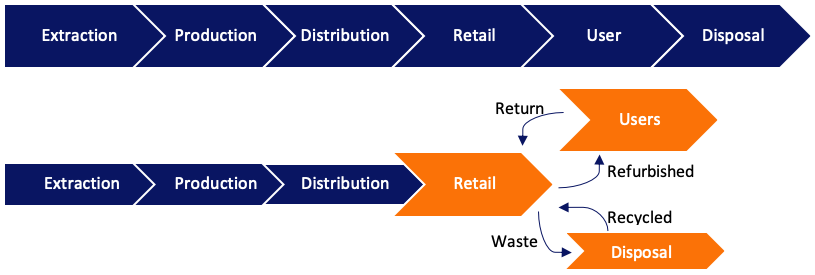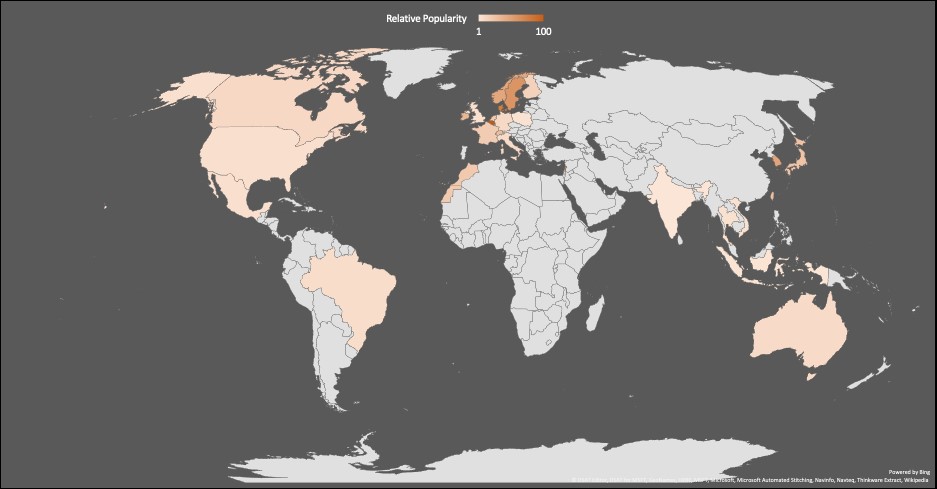The Circular Economy Meets Furniture: The Future of Rentals and Sharing
According to a 2017 estimate, the global sharing economy will surpass $335 billion by 2025, with a CAGR of 30.2%. The gradual shift from the mainstream, buy-and-dispose, linear economy to a sharing economy is visible across the globe and now includes multiple industries, including vehicle rental, ride sharing, accommodation and clothing.
Now, it’s the turn of the furniture industry, an emerging sector undergoing significant change. Valued at $574 billion in 2020, innovators are applying sharing economy principles to resource ownership. This asset heavy industry, in which most consumers opt for one-off purchases, is now stepping into the sharing economy model to allow for furniture rental.

Attractiveness: Why Use Used?
Furniture rental offers consumers the option to lease products of their choice without a long-term commitment while also providing greater flexibility to keep up with changing trends and requirements. The rental system also caters to the environmentally-conscious consumer, as products typically discarded are re-used, refurbished or recycled in the process. For example, furniture and furnishings waste amounted to 12.2 million tons in the United States alone in 2017.
The rise in urbanization is a major driver in the adoption of furniture rental, as high population densities allow for concentrations of demand and supply. For those who relocate frequently, the hassle of moving or discarding furniture can be avoided. The rise of digitalization and the adoption of digital platforms by consumers is also enabling the provision of efficient rental services, as online product visualization and purchasing become mainstream.

Upstream Business Models
There are three primary upstream business models in this space: external furniture suppliers, peer-to-peer and full-stack model approach.
External Furniture Providers
The most common upstream supply chain model used by innovators is to develop a marketplace with products from external furniture providers. Through strategic partnerships with furniture manufacturers, start-ups can source products depending on demand, thus reducing warehousing costs. Examples of innovators using this model include:
- Rentomojo has raised over $45 million and was part of Google Launchpad Accelerator. It has received funding from investors including Samsung Ventures, supporting the increasing interest in shifting to rental models for products such as electronic devices. Rentomojo has been able to scale its operations to multiple cities in India and offers free relocation and product exchange services.
- CasaOne has raised over $27 million and is backed by Accel and WeWork Creator Fund. CasaOne offers office furniture rental through its sister company BureauOne, with customers including Airbnb, Facebook, and WeWork. It also offers customized 2D/3D visualizations and expert advice to help customers with their choices. With funds raised in 2019, CasaOne had planned to expand its operations to London in early 2020 (currently delayed).
- Feather raised $30 million in 2020 in a round led by Cobalt Capital and is a Y Combinator cohort company. It offers “fashionable” furniture to a primarily millennial customer base, with product aesthetic as its stand apart factor. It recently partnered with a reforestation organization to help offset its supply chain and logistics carbon footprint.
- Fernish was part of Techstars Los Angeles Accelerator and has raised $15 million in 2020 in a round led by Khosla Ventures. Fernish sets itself out as an eco-friendly solution provider through its refurbishment and relocation services, with millennials as the core customer target. It currently operates in Los Angeles and Seattle with plans to enter additional markets in 2020 and further develop its proprietary software.
Peer-to-Peer
Another emerging model is a peer-to-peer rental marketplace for household products such as furniture, garden tools, recreational vehicles and mobility scooters amongst others. One innovator offering furniture through this model includes Peerby which has raised $4.7 million since its inception in 2011. With free registration, it charges the lender a commission for products advertised. The platform allows users to “borrow” items from the nearest lenders and advertise need for product that may not be available. This model capitalizes on idle capacity of resources and does not involve the provision of logistic services.
Full-Stack Model
Innovators are also looking into a full-stack model, where they design and manufacture their own furniture and rent it through an online platform. For example, Furlenco raised $10 million in 2020 from Lightbox Ventures and Vivriti Capital. Although the up-front cost of this business model is high, it allows the start-up to cater to its demographics’ needs and provide better in-house refurbishment and recycling services. However, warehousing costs are high in this model and it requires a steady product movement cycle to prevent over or under stocking.
Downstream Business Models
All startups currently on the market operate on a subscription-based rental model for consumers with a varying range of rental periods offered. This model helps retain long-term relationships with clients, an essential element due to the high costs of customer acquisition. This is a proven model adapted from other business areas such as software-as-a-service, food-box subscriptions, car rental etc. As stand apart factors, start-ups are incorporating different aspects into the model, including:
- Subscription-based with return – Products are returned at the end of the rental period or exchanged for different products.
- Subscription-based with option to purchase – Customers can buy rented products with amount already paid deducted from selling price.
- Rental packages – Start-ups are offering to furnish whole rooms with consumers either choosing from set-designs or personalizing the package.
- Short-term rental – Catering to event organizers and house stagers, this model gives clients the option to obtain their choice of furniture for a short period of time.
Feather, alongside its subscription model, offers a membership model where consumers pay a monthly fee to access discounted furniture items, free delivery and assembly, and the option to swap one furniture item yearly for free. This helps engage consumers and build loyalty.
Competitors
Traditional furniture providers are also adopting circular economy models, embracing the rental trend. In response to changing consumer behavior, flat-pack furniture giant IKEA announced a testing phase for furniture rental starting in 2020 at stores in Europe, North America, India and Australia. With this pilot, IKEA aims to test the durability, ease of assembly/disassembly and transportation of its products.
Rent the Runway, a rental service provider for high-end clothes, entered a partnership with West Elm, a furniture manufacturer and retailer in 2019 to expand its operations into furniture rental. Subscribers from Rent the Runway now have access to set products from West Elm for bedroom and living room furnishings.
By partnering with start-ups, furniture corporates are offering their products for rental without having to adapt their digital platform and business model or extend their logistics capabilities. For example, West Elm has been featuring its products on start-up Feather’s platform, while FLOYD and Crate & Barrel have partnered with Fernish. Although these partnerships are essential for start-ups retailing corporates’ products, innovators like Furlenco have to compete with name-brands renting on multiple platforms.
Hurdles Ahead
For rental models to be successful, customer acquisition and retention costs need to be minimized. Start-ups need to understand their target demographic and ensure customers are engaged to overcome these costs.
Given the relative novelty of furniture rental, start-ups need to develop and test different pricing models to find the best fit for their demographic, particularly as sharing models gain traction and changing lifestyles support their adoption. Factors such as base cost of furniture, furnishings, design service, last-mile delivery, assembly, relocation and exchange services all need to be taken into account when pricing each product. Start-ups need to work out their optimal offering between price and other services offered with the product. The cost of wear and tear combined with the fluctuating value due to changing trends also needs to be calculated and taken into consideration.
Bad debts or write-ups are another hurdle facing rental start-ups, as checks need to be put in place to ensure customers can pay regularly and care for the products rented out. For example, Feather has opted to use credit score checks to evaluate its customers before approving transactions, but for non-American-based start-ups, the hurdle remains.
And Finally…
The emerging success and adoption of furniture rental shows that there is a business case to move away from linear economy models in general. This is particularly relevant given the straightforward nature of the traditional long-term ownership. Coupled with the advantages of incorporating a circular economy and promoting sustainable goals, the sharing economy seems set to not only to stay but to grow in the coming years.


